Red Spider Lily
- March 22, 2024
- 0 comment
The Red Spider Lily, scientifically named Lycoris radiata, is a stunning flowering plant native to China, Korea, and Nepal. Its beautiful and distinct look has made it a top pick for gardens and landscapes globally.

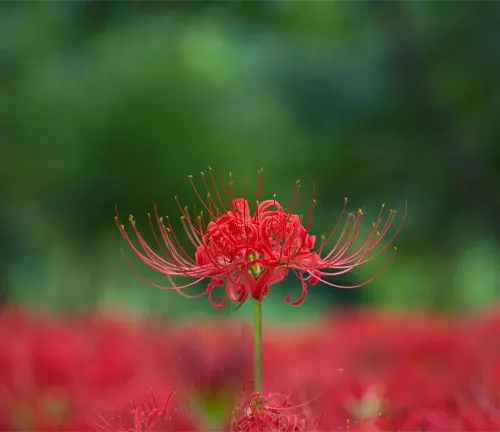
The vibrant red blooms and long stamens of this plant give it a captivating and unforgettable appearance, attracting the admiration of many garden enthusiasts.
Characteristics of Red Spider Lily
| Characteristics | Description |
| Scientific Name | Lycoris radiata |
| Common Names | Red Spider Lily, Hurricane Lily, Red Magic Lily, Cluster Amaryllis |
| Family | Amaryllidaceae |
| Native Region | China, Korea, and Nepal |
| Plant Type | Perennial herb |
| Size | The Red Spider Lily typically grows to a height of 12 to 18 inches (30 to 45 cm) |
| Leaves | The plant has long, strap-like green leaves that emerge after the flowers have withered |
| Flowers | The Red Spider Lily produces clusters of bright red, spider-like flowers with long stamens, giving it a distinctive and mesmerizing appearance |
| Propagation | It propagates through bulbs and offsets |
| Drought Tolerance | Red Spider Lilies are known for their excellent drought tolerance, making them suitable for xeriscaping and low-maintenance gardening |
| Cultural Uses | In Japan, the Red Spider Lily is associated with death and is often planted near graves and in other memorial locations |
| Ecological Role | The plant is not only valued for its ornamental beauty but also plays a role in supporting pollinators such as bees and butterflies |
| Notable Species | Lycoris aurea (Yellow Spider Lily), Lycoris sanguinea (Red Swamp Lily) |
| Hardiness Zones | Red Spider Lilies thrive in USDA hardiness zones 7 to 10 |
| Growth Rate | The plant has a moderate growth rate |
| Lifespan | Red Spider Lilies are long-lived perennials, with some specimens living for decades |
Botanical Beauty of “Red Spider Lily”
The Red Spider Lily is famous for its beautiful and eye-catching appearance, making it a favorite for bringing a burst of bright color to gardens and landscapes. Its vivid red petals create a striking contrast against the green surroundings, making it a standout feature that catches everyone’s attention.

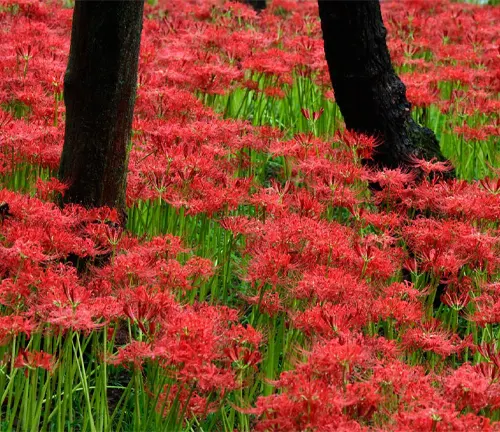
Woodland Elegance
The Red Spider Lily naturally grows in woodlands and meadows, where its bright flowers add a touch of beauty to the surroundings. Its ability to grow well in shaded areas makes it a great choice for adding elegance to woodland gardens, making it a valuable addition for anyone looking to enhance the natural beauty of their outdoor spaces.
Ecological Importance
Apart from being beautiful, the Red Spider Lily also helps bees and butterflies by giving them food. When it grows in natural areas, it helps to make sure there are many different plants and animals, which is good for the environment.
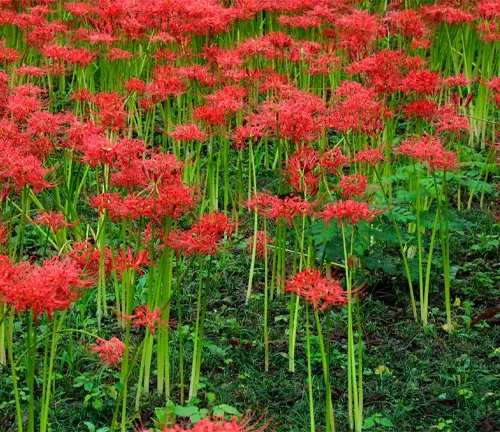
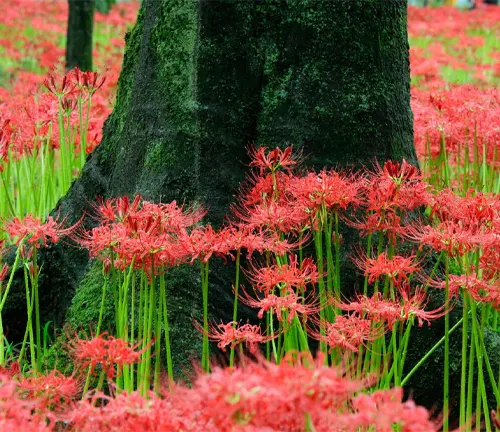
Cultivation and Conservation
Red Spider Lilies are widely grown in gardens and parks around the world, helping to preserve and promote the conservation of this species beyond its native regions. However, it’s equally important to focus on protecting its natural habitats to ensure the plant’s survival in the wild.
By cultivating these beautiful flowers, people are not only adding to the aesthetic appeal of their surroundings but also participating in the conservation of a species outside its original habitat. This dual approach of cultivation and conservation plays a crucial role in maintaining the presence of Red Spider Lilies both in human-designed landscapes and in their natural environments.
Fragrance
The Red Spider Lily, scientifically known as Lycoris radiata, is a captivating flower that not only boasts stunning coral red blooms but also emits a delicate and sweet fragrance. This late-summer bloomer, thriving in zones 5-10, is a favorite for many garden enthusiasts due to its unique beauty and the added sensory delight of its fragrant nature.
The aroma of the Red Spider Lily is described as light and lemony, offering a refreshing and invigorating scent that can brighten up any space. Its fragrance, combined with its striking appearance, makes it a must-have addition to gardens looking to add both visual appeal and a pleasant olfactory experience. In the realm of perfumery, the red spider lily note has been incorporated into various fragrances, such as the Gucci Gucci by Gucci Eau de Parfum and Jimmy Choo’s I Want Choo Eau De Parfum.
These perfumes aim to capture the essence of the Red Spider Lily’s beautiful scent, blending it with other notes like vanilla and jasmine to create deep, uplifting floral fragrances. The allure of the Red Spider Lily’s fragrance has inspired perfumers to harness its light, heavenly aroma, translating the natural beauty of this flower into captivating scents that can be enjoyed year-round.
Soil Stabilization
The Red Spider Lily, also known as Lycoris radiata, plays a vital role in soil stabilization due to its robust and extensive root system. These roots spread out deeply and widely, helping to anchor the soil and prevent erosion in areas where they are planted. By holding the soil in place, the Red Spider Lily contributes to maintaining the integrity of the ground, especially in regions prone to erosion or with loose soil.
In addition to its aesthetic appeal and fragrant blooms, the Red Spider Lily’s ability to stabilize soil makes it a valuable asset in landscaping and gardening. Whether planted in gardens, along slopes, or in natural areas, this flower’s root system works tirelessly beneath the surface to keep the soil secure and prevent erosion. By choosing to incorporate the Red Spider Lily into landscaping projects, individuals can not only enjoy its beauty but also benefit from its soil-stabilizing properties, creating a more sustainable and resilient environment.
Common Uses
The Red Spider Lily, scientifically known as Lycoris radiata, is a versatile flower with common uses in ornamental gardens, landscaping, and floral arrangements. In ornamental gardens, this striking flower adds a pop of vibrant color and elegance, enhancing the overall aesthetic appeal of the space. Its unique appearance and mild fragrance make it a popular choice for gardeners looking to create visually stunning landscapes.
In landscaping, the Red Spider Lily’s ability to thrive in various conditions and its soil-stabilizing roots make it a valuable asset. Whether planted along borders, in clusters, or as standalone features, this flower can transform outdoor spaces with its beauty and contribute to soil stability. Additionally, its resilience and low maintenance requirements make it a practical choice for landscaping projects of all sizes.
When it comes to floral arrangements, the Red Spider Lily’s bold blooms and long, sturdy stems make it a favorite among florists. Whether used in bouquets, centerpieces, or other floral displays, this flower adds a touch of drama and sophistication. Its versatility in both fresh and dried arrangements makes it a go-to choice for adding a splash of color and elegance to any setting.
Benefits
The Red Spider Lily, or Lycoris radiata, offers a range of benefits that make it a popular choice for gardens. One key advantage is its low-maintenance nature, requiring minimal care once established. This makes it an ideal plant for busy gardeners or those looking for easy-to-grow flowers that still provide a stunning display. Another benefit of the Red Spider Lily is its ability to attract pollinators such as bees and butterflies.
By drawing these beneficial insects to the garden, the flower supports local ecosystems and promotes biodiversity. This not only enhances the health of the garden but also contributes to the overall well-being of the surrounding environment. Furthermore, the Red Spider Lily adds vibrant color to gardens, creating eye-catching displays that brighten up outdoor spaces.
Its striking coral-red blooms stand out against green foliage, adding a touch of drama and beauty to any landscape. Whether planted in clusters or as individual specimens, this flower brings a burst of color that can uplift and transform garden settings, making it a valuable addition for those seeking to create visually appealing outdoor spaces.
Different Species
Lycoris radiata (Red Spider Lily)
This is the most well-known species, characterized by its striking clusters of vibrant red, spider-like flowers. It is native to China, Korea, and Nepal and is widely cultivated for its ornamental value.
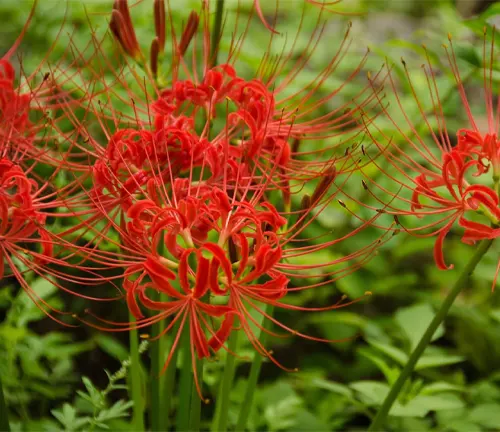
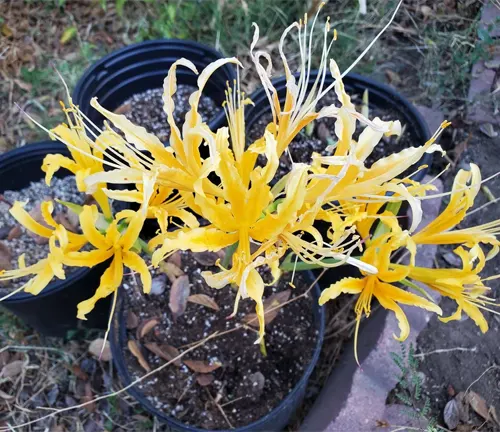
Lycoris aurea (Yellow Spider Lily)
As the name suggests, this species is distinguished by its stunning yellow blooms. It is native to China and is valued for its bright and cheerful appearance, offering a unique color variation within the Lycoris genus.
Lycoris longituba (White Spider Lily)
Unlike the traditional red color of the Red Spider Lily, this species produces elegant white flowers. Native to China, it offers a graceful and serene alternative to the more commonly seen red varieties.

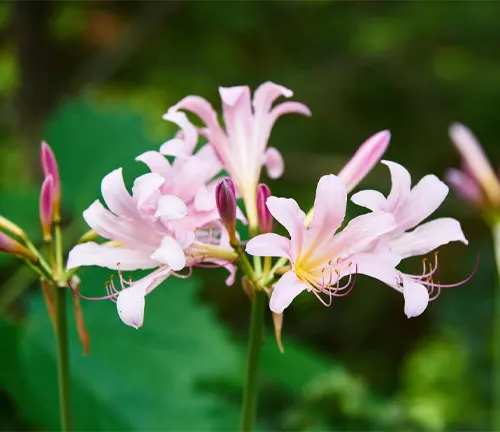
Lycoris squamigera (Magic Lily)
Also known as the Surprise Lily, this species stands out for its unique blooming pattern. The foliage emerges in spring, while the flowers appear in late summer or early autumn, creating a surprising and enchanting display.
Frequently Asked Questions (FAQs)
1. What is the best time to plant Red Spider Lily bulbs?
The ideal time to plant Red Spider Lily bulbs is in late summer or early fall. This allows the bulbs to establish themselves before the winter and bloom beautifully in the following late summer or early autumn.
2. Can Red Spider Lilies grow in full shade?
Red Spider Lilies prefer partial shade to full sun. While they can tolerate some degree of shade, too much can lead to reduced flowering. A location with morning sun and afternoon shade often yields the best results.
3. How often should I water Red Spider Lilies?
These plants are drought-tolerant once established. Water them moderately after planting until they are well-rooted. Once established, they require very little supplemental watering, except in extremely dry conditions.
4. Are Red Spider Lilies toxic to pets?
Yes, Red Spider Lilies contain lycorine and other alkaloids that can be toxic to pets if ingested. It’s important to plant them in areas away from pets or monitor pets closely in the garden.
5. How do Red Spider Lilies support pollinators?
Red Spider Lilies produce nectar that attracts pollinators such as bees and butterflies. By providing a food source for these pollinators, they contribute to the health of the local ecosystem.
6. Can I grow Red Spider Lilies in containers?
Yes, Red Spider Lilies can be grown in containers, provided they have adequate drainage. Container-grown lilies may need more frequent watering than those in the ground.
7. What is the significance of Red Spider Lilies in Japanese culture?
In Japan, Red Spider Lilies are often associated with death and the afterlife, which is why they are commonly planted around graves and used in funerals. They are believed to guide the souls of the departed to their next reincarnation.
8. How long does it take for Red Spider Lilies to bloom after planting?
Red Spider Lilies typically bloom in late summer to early autumn, around 6-8 weeks after planting. However, newly planted bulbs might not bloom in their first year as they establish themselves.
9. Do Red Spider Lilies come back every year?
Yes, Red Spider Lilies are perennials and will return each year. They may even multiply and spread over time, creating larger clusters of blooms.
10. How can I encourage more blooms from my Red Spider Lilies?
To encourage more blooms, ensure your Red Spider Lilies are planted in a suitable location with partial shade to full sun and well-drained soil. After blooming, allow the leaves to remain until they yellow and die back naturally to help nourish the bulbs for the next season’s blooms. Division of overcrowded clumps every few years can also rejuvenate and increase flowering.






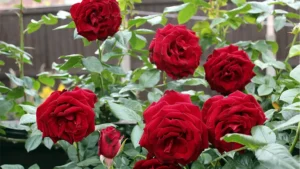

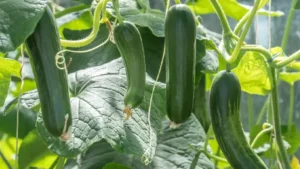

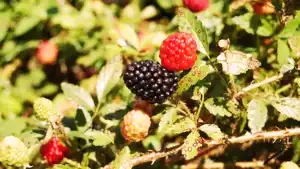



Leave your comment